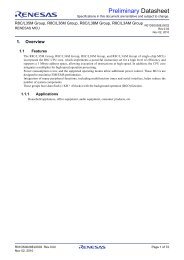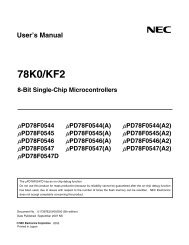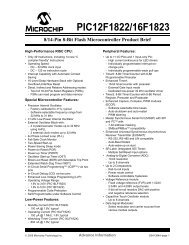xmega a3u - Elfa
xmega a3u - Elfa
xmega a3u - Elfa
You also want an ePaper? Increase the reach of your titles
YUMPU automatically turns print PDFs into web optimized ePapers that Google loves.
XMEGA A3U<br />
27. CRC – Cyclic Redundancy Check Generator<br />
27.1 Features<br />
27.2 Overview<br />
• Cyclic redundancy check (CRC) generation and checking for<br />
– Communication data<br />
– Program or data in flash memory<br />
– Data in SRAM and I/O memory space<br />
• Integrated with flash memory, DMA controller and CPU<br />
– Continuous CRC on data going through a DMA channel<br />
– Automatic CRC of the complete or a selectable range of the flash memory<br />
– CPU can load data to the CRC generator through the I/O interface<br />
• CRC polynomial software selectable to<br />
– CRC-16 (CRC-CCITT)<br />
– CRC-32 (IEEE 802.3)<br />
• Zero remainder detection<br />
A cyclic redundancy check (CRC) is an error detection technique test algorithm used to find<br />
accidental errors in data, and it is commonly used to determine the correctness of a data transmission,<br />
and data present in the data and program memories. A CRC takes a data stream or a<br />
block of data as input and generates a 16- or 32-bit output that can be appended to the data and<br />
used as a checksum. When the same data are later received or read, the device or application<br />
repeats the calculation. If the new CRC result does not match the one calculated earlier, the<br />
block contains a data error. The application will then detect this and may take a corrective<br />
action, such as requesting the data to be sent again or simply not using the incorrect data.<br />
Typically, an n-bit CRC applied to a data block of arbitrary length will detect any single error<br />
burst not longer than n bits (any single alteration that spans no more than n bits of the data), and<br />
will detect the fraction 1-2 -n of all longer error bursts. The CRC module in Atmel AVR XMEGA<br />
devices supports two commonly used CRC polynomials; CRC-16 (CRC-CCITT) and CRC-32<br />
(IEEE 802.3).<br />
• CRC-16:<br />
Polynomial: x 16 +x 12 +x 5 +1<br />
Hex value:<br />
0x1021<br />
• CRC-32:<br />
Polynomial:<br />
Hex value:<br />
x 32 +x 26 +x 23 +x 22 +x 16 +x 12 +x 11 +x 10 +x 8 +x 7 +x 5 +x 4 +x 2 +x+1<br />
0x04C11DB7<br />
8386B–AVR–12/11<br />
49

















